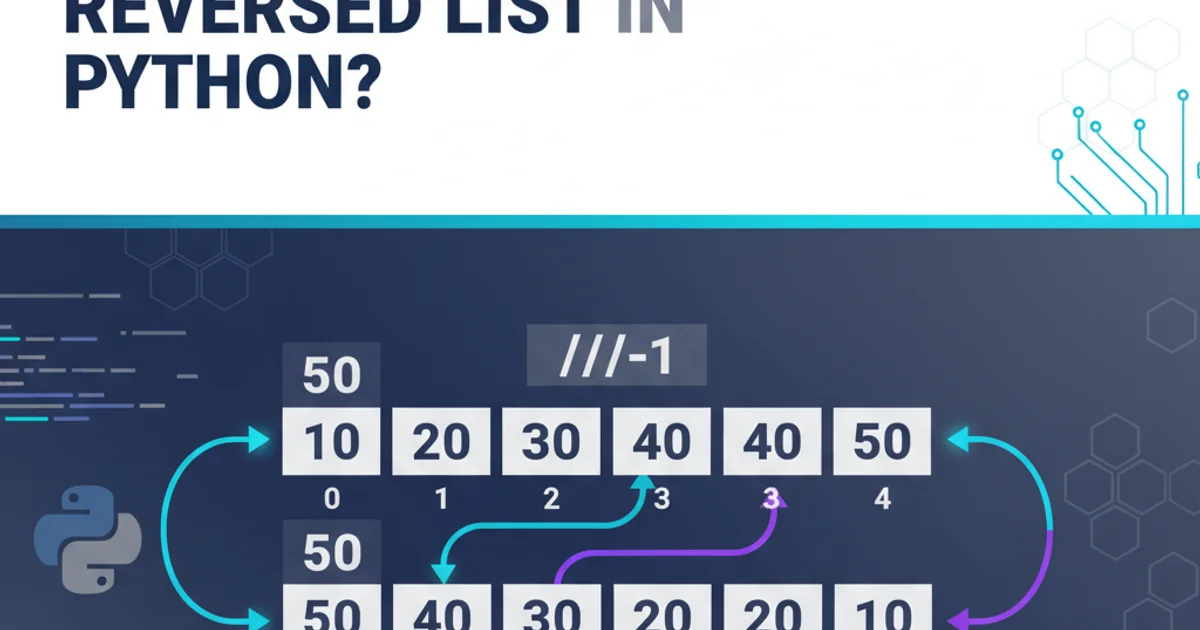Why does this "[::-1]" return a reversed list in Python?
Categories:
Understanding Python's [::-1] Slice for List Reversal

Explore the mechanics behind Python's powerful [::-1] slicing notation and how it efficiently reverses lists, strings, and other sequences.
Python offers a variety of elegant ways to manipulate data structures. One of the most concise and frequently encountered methods for reversing sequences, particularly lists and strings, is the [::-1] slice. While seemingly magical at first glance, this notation is a powerful application of Python's extended slicing capabilities. This article will demystify [::-1], breaking down its components and illustrating why it works so effectively for sequence reversal.
The Fundamentals of Python Slicing
Before diving into [::-1], it's crucial to understand basic Python slicing. Slicing allows you to extract a portion of a sequence (like a list or string) by specifying a start, end, and step. The general syntax for slicing is sequence[start:end:step].
Let's break down each component:
1. start (Optional)
The index where the slice begins. If omitted, it defaults to the beginning of the sequence (index 0).
2. end (Optional)
The index where the slice ends. The element at this index is not included. If omitted, it defaults to the end of the sequence.
3. step (Optional)
The increment between elements. If omitted, it defaults to 1 (meaning every element is included). A positive step moves forward, while a negative step moves backward.
my_list = [0, 1, 2, 3, 4, 5, 6, 7, 8, 9]
# Basic slicing examples
print(my_list[2:7]) # Output: [2, 3, 4, 5, 6] (elements from index 2 up to, but not including, 7)
print(my_list[:5]) # Output: [0, 1, 2, 3, 4] (elements from start up to, but not including, 5)
print(my_list[5:]) # Output: [5, 6, 7, 8, 9] (elements from index 5 to the end)
print(my_list[::2]) # Output: [0, 2, 4, 6, 8] (every second element, starting from the beginning)
print(my_list[1::3]) # Output: [1, 4, 7] (every third element, starting from index 1)
Examples of basic Python list slicing.
The Magic of [::-1] Explained
Now, let's apply our understanding of slicing to [::-1]. In this notation, both the start and end parameters are omitted, and the step parameter is set to -1.
flowchart TD
A["Sequence[start:end:step]"] --> B{"start omitted"}
B --> C{"end omitted"}
C --> D["step = -1"]
D --> E["Result: Reversed Sequence"]
E --> F["Creates a new sequence (shallow copy)"]Breakdown of the [::-1] slicing mechanism.
Here's what each part signifies:
1. Omitted start
When step is negative, an omitted start defaults to the end of the sequence. For a list of length N, this means it effectively starts at index N-1.
2. Omitted end
Similarly, when step is negative, an omitted end defaults to the beginning of the sequence. This means it effectively goes up to, but not including, index -N-1 (or conceptually, 'before the first element').
3. step = -1
This is the key. A negative step value tells Python to traverse the sequence backward, one element at a time.
Combining these, [::-1] instructs Python to start at the very end of the sequence, move backward one element at a time, and continue until it reaches the very beginning. The result is a new sequence containing all the elements of the original, but in reverse order.
original_list = [10, 20, 30, 40, 50]
reversed_list = original_list[::-1]
print(reversed_list) # Output: [50, 40, 30, 20, 10]
original_string = "Hello Python"
reversed_string = original_string[::-1]
print(reversed_string) # Output: "nohtyP olleH"
Applying [::-1] to lists and strings.
[::-1] slice creates a new reversed sequence. It does not modify the original sequence in place. If you need to reverse a list in place, use the list.reverse() method.Performance Considerations and Alternatives
The [::-1] slice is generally very efficient for reversing sequences in Python because it's implemented in C under the hood. However, it's not the only way to reverse a sequence, and understanding alternatives can be useful for specific scenarios.
Here's a comparison of common reversal methods:
Using [::-1] (Slicing)
my_list = [1, 2, 3, 4, 5]
reversed_list = my_list[::-1]
# Creates a new list
Using list.reverse() (In-place)
my_list = [1, 2, 3, 4, 5]
my_list.reverse()
# Modifies the original list
Using reversed() (Iterator)
my_list = [1, 2, 3, 4, 5]
reversed_iterator = reversed(my_list)
reversed_list = list(reversed_iterator)
# Returns an iterator, then converts to list
reversed() can be more memory-efficient than [::-1] because it returns an iterator that yields elements one by one, rather than creating a full new copy of the sequence in memory immediately.